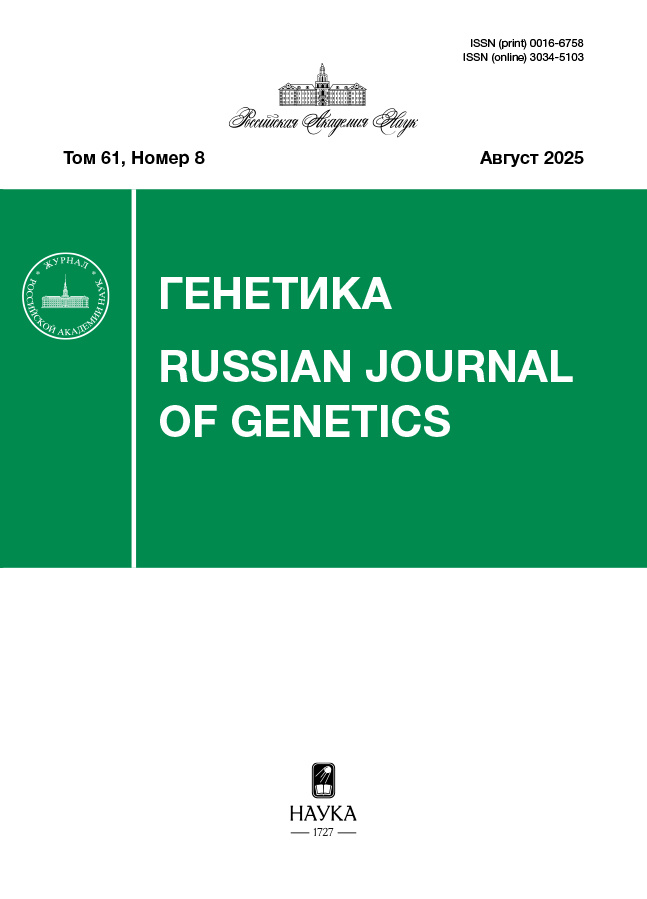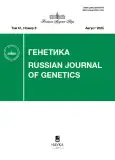ВНУТРИГЕНОМНЫЙ ПОЛИМОРФИЗМ И ПСЕВДОГЕНИЗАЦИЯ ГЕНА OCA2 У ДАЛЬНЕВОСТОЧНЫХ СОВ (Strigidae, Aves)
- Авторы: Спиридонова Л.Н.1, Сурмач С.Г.1
-
Учреждения:
- Федеральный научный центр Биоразнообразия Дальневосточного отделения Российской академии наук
- Выпуск: Том 61, № 8 (2025)
- Страницы: 48-61
- Раздел: ГЕНЕТИКА ЖИВОТНЫХ
- URL: https://vestnik.nvsu.ru/0016-6758/article/view/693813
- DOI: https://doi.org/10.31857/S0016675825080051
- ID: 693813
Цитировать
Полный текст
Аннотация
На примере семи дальневосточных видов сов: филина Bubo bubo, рыбного филина Bubo (Ketupa) blakistoni, полярной совы Bubo (Nyctea) scandiacus, ушастой совы Asio otus, длиннохвостой неясыти Strix uralensis, восточной совки Otus sunia и японской совки Otus semitorques впервые исследован внутригеномный полиморфизм фрагмента гена OCA2 (около 4800 пн), кодирующего трансмембранный P-белок, связанный с окраской оперения птиц. Внутригеномная изменчивость OCA2 в этой разнородной группе совообразных изменялась от 0.005 у B. bubo до 0.014 у O. sunia, что превышает межвидовые значения по данному гену в родах Falco и Cygnus (0.000–0.006). Генетические дистанции между родами в сем. Strigidae широко варьировали (0.022–0.048), однако примерно соответствовали уровню таковых в сем. Accipitridae (0.015–0.040). Впервые у некоторых исследованных видов обнаружены факты псевдогенизации гена OCA2, полученные на основании сравнения экзонных областей кодирующего гена и разных вариантов его копий. Для O. semitorques выявлено два варианта псевдогена, для B. (N.) scandiacus – три, а для B. bubo – восемь. Для псевдогенов OCA2 обнаружен высокий уровень внутригеномного полиморфизма, обусловленный многими единичными мутациями, вставками и делециями разной длины. Для некоторых пар видов, спорно относимых к одному роду, выявлена глубокая дифференциация, соответствующая межродовому уровню генетических дистанций для гена OCA2 в других отрядах, что добавляет аргументов в пользу их родовой самостоятельности: O. sunia – O. semitorques (0.031), B. bubo – B. (K.) blakistoni (0.024) и B. (K.) blakistoni – B. (N.) scandiacus (0.022). Реконструкция филогенетических отношений совообразных и других исследованных таксонов по гену OCA2 в целом согласуется с построениями по другим молекулярным маркерам.
Ключевые слова
Об авторах
Л. Н. Спиридонова
Федеральный научный центр Биоразнообразия Дальневосточного отделения Российской академии наук
Автор, ответственный за переписку.
Email: spiridonova@biosoil.ru
Владивосток, 690022 Россия
С. Г. Сурмач
Федеральный научный центр Биоразнообразия Дальневосточного отделения Российской академии наук
Email: spiridonova@biosoil.ru
Владивосток, 690022 Россия
Список литературы
- Galvan I., Garcia-Campa J., Negro J.J. Complex plumage patterns can be produced only with the contribution of melanins // Physiol. Biochem. Zool. 2017. V. 90. № 5. P. 600–604. https://doi.org/10.1086/693962
- Galván I., Rodríguez-Martínez S. A negative association between melanin-based plumage color heterogeneity and intensity in birds // Physiol. Biochem. Zool. 2019. V. 92. № 3. P. 266–273. https://doi.org/10.1086/702720.
- Hirobe T., Kawa Y., Mizoguchi M. et al. Effects of ge-nic substitution at the pink-eyed dilution locus on the proliferation and differentiation of mouse epidermal melanocytes in vivo and in vitro // J. Exp. Zool. 2002. V. 292. P. 351–366.
- Rosemblat S., Sviderskaya E.V., Easty D.J. et al. Melanosomal defects in melanocytes from mice lacking expression of the pink-eyed dilution gene: Correction by culture in the presence of excess tyrosine // Exp. Cell Res. 1998. V. 239 (2). P. 344–352. https://doi.org/10.1006/excr.1997.3901.
- Liu X., Zhou R., Peng Y. et al. Feather follicles trans- criptome profiles in Bashang long-tailed chickens with different plumage colors // Genes & Genomics. 2019. V. 41. № 11. P. 1357–1367. https://doi.org/10.1007/s13258-018-0740-y
- Abolins-Abols M., Kornobis E., Ribeca P. et al. Diffe- rential gene regulation underlies variation in melanic plumage coloration in the dark-eyed junco (Junco hyemalis) // Mol. Ecol. 2018. V. 27. № 22. P. 4501–4515. https://doi.org/10.1111/mec.14878
- Poelstra J.W., Vijay N., Hoeppner M.P., Wolf J.B. Transcriptomics of colour patterning and colo- ration shifts in crows // Mol. Ecol. 2015. V. 24. № 18. P. 4617–4628. https://doi.org/10.1111/mec.13353
- Bellono N.W., Escobar I.E., Lefkovith A.J. et al. An intracellular anion channel critical for pigmentation // Elife. 2014. V. 3. P. e04543. https://doi.org/10.7554/eLife.04543
- Puri N., Gardner J.M., Brilliant M.H. Aberrant pH of melanosomes in pink-eyed dilution (p) mutant melanocytes // J. Invest. Dermatol. 2000. V. 115 (4). P. 607–13. https://doi.org/10.1046/j.1523-1747.2000.00108.x.
- Sturm R.A., Frudakis T.N. Eye colour: Portals into pigmentation genes and ancestry // Trends Genet. 2004. V. 20 (8). P. 327–332. http://dx.doi.org/10.1016/j.tig.2004.06.010
- Walsh S., Liu F., Wollstein A. et al. The HIrisPlex system for simultaneous prediction of hair and eye colour from DNA // Forensic Sci. Int.: Genetics. 2013. V. 7 (1). P. 98–115. http://dx.doi.org/10.1016/j.fsigen.2012.07.005
- Zhu G., Evans D.M., Duffy D.L. et al. A genome scan for eye color in 502 twin families: Most variation is due to a QTL on chromosome 15q // Twin Research. 2004. V. 2. P. 197–210.
- Duffy D.L., Montgomery G.W., Chen W. et al. A Three–single–nucleotide polymorphism haplotype in intron 1 of OCA2 explains most human eye- color variation // Am. J. Hum. Genet. 2007. V. 80. P. 241–252. https://doi.org/10.1086/510885
- Orlow S.J., Brilliant M.H. The pinkeyed dilution locus controls the biogenesis of melanosomes and levels of melanosomal proteins in the eye // Exp. Eye Res. 1999. V. 68. P. 147–154. https://doi.org/10.1006/exer.1998.0599
- Caduff M., Bauer A., Jagannathan V., Leeb T. OCA2 splice site variant in German Spitz dogs with oculocutaneous albinism // PLoS One. 2017. V. 12 (10). https://doi.org/10.1371/journal.pone.0185944
- Brilliant M.H. The mouse p (pink-eyed dilution) and human P genes, oculocutaneous albinism type 2 (OCA2), and melanosomal pH // Pigment. Cell Res. 2001. V. 14. P. 86–93.
- Lopes R.J., Johnson J.D., Toomey M.B. et al. Genetic basis for red coloration in birds // Curr. Biol. 2016. V. 26 (11). P. 1427–1434. https://doi.org/10.1016/j.cub.2016.03.076
- Toews D.P., Taylor S.A., Vallender R. et al. Plumage genes and little else distinguish the genomes of hybridizing warblers // Curr. Biol. 2016. V. 26 (17). P. 2313–2318. https://doi.org/10.1016/j.cub.2016.06.034
- Corbett E.C., Brumfield R.T., Faircloth B.C. The me- chanistic, genetic and evolutionary causes of bird eye colour variation // Ibis. 2024. V. 166. V. 560–589. https://doi.org/10.1111/ibi.13276
- Маниатис Т., Фрич Э., Сэмбрук Дж. Методы генетической инженерии. Молекулярное клонирование. М.: Мир, 1984.
- Bonfield J.K., Smith K.F., Staden R. A new DNA sequence assembly program // Nucl. Ac. Res. 1995. V. 23. P. 4992–4999.
- Kumar S., Stecher G., and Tamura K. MEGA7: Molecular evolutionary genetics analysis version 7.0 for bigger datasets // Mol. Biol. and Evol. 2016. V. 33. P. 1870–1874. https://doi.org/10.1093/molbev/msw054
- Nei M. Molecular Evolutionary Genetics. N.Y.: Columbia Univ. Press, 1987.
- Librado P., Rozas J. DnaSP v5: A software for comprehensive analysis of DNA polymorphism data // Bioinformatics. 2009. V. 25. P. 1451–1452.
- Posada D., Crandall K.A. Modeltest: Testing the model of DNA substitution // Bioinformatics. 1998. V. 14. P. 817–818.
- Tamura K., Nei M., Kumar S. Prospects for inferring very large phylogenies by using the neighbor-joining method // Proc. Natl Acad. Sci. USA. 2004. V. 101. P. 11030–11035. https://doi.org/10.1073/pnas.0404206101
- Waterhouse A., Bertoni M., Bienert S. et al. SWISS-MODEL: Homology modelling of protein structures and complexes // Nucl. Acids Res. 2018. V. 46. W296–W303. https://doi.org/10.1093/nar/gky427
- Ronquist F., Teslenko M., van der Mark P. et al. MRBAYES 3.2: Efficient Bayesian phylogenetic inference and model selection across a large model space // Syst. Biol. 2012. V. 61. P. 539–542. https://doi.org/10.1093/sysbio/sys029
- Felsenstein J. Confidence limits on phylogenies: An approach using the bootstrap // Evolution. 1985. V. 39. P. 783–791.
- Rambaut A., Drummond A.J., Xie D. et al. Posterior summarization in Bayesian phylogenetics using Tracer 1.7 // Syst. Biol. 2018. V. 67. № 5. P. 901–904. https://doi.org/10.1093/sysbio/syy032
- Nei M., Kumar S. Molecular Evolution and Phylogenetics. Oxford: Univ. Press, 2000.
- Prum R., Berv J., Dornburg A. et al. A comprehensive phylogeny of birds (Aves) using targeted next-generation DNA sequencing // Nature. 2015. V. 526. P. 569–573. https://doi.org/10.1038/nature15697
- Stiller J., Feng S., Chowdhury A.A. et al. Complexity of avian evolution revealed by family-level genomes // Nature. 2024. V. 629. P. 851–860. https://doi.org/10.1038/s41586-024-07323-1.
- Rose A.B. Introns as gene regulators: A brick on the accelerator // Front. Genet. 2019. V. 9. Article 672. https://doi.org/10.3389/fgene.2018.00672.
- Neff B.D., Gross M.R. Microsatellite evolution in vertebrates: inference from AC dinucleotide repeats // Evolution. 2001. V. 55 (9). P. 1717–1733. https://doi.org/10.1111/j.0014-3820.2001.tb00822.x.
- Шаповал Н.А., Лухтанов В.А. Рибосомная ДНК в кариосистематике и молекулярной филогенетике бабочек-голубянок рода Polyommatus (Lepido- ptera, Lycaenidae) // Бюл. мед. интернет-конф., Т. 6. № 9. 2016. С. 1509–1509.
- Freeman J.L., Perry G.H., Feuk L. et al. Copy number variation: new insights in genome diversity // Genome Res. 2006. V. 16 (8). P. 949–961. https://doi.org/10.1101/gr.3677206.
- Vickrey A.I., Bruders R., Kronenberg Z. et al. Introgression of regulatory alleles and a missense coding mutation drive plumage pattern diversity in the rock pigeon // Elife. 2018. V. 7. P. e34803. https://doi.org/10.7554/eLife.34803
- Kehrer-Sawatzki H. What a difference copy number variation makes // Bioessays. 2007. V. 29 (4). P. 311–313. https://doi.org/10.1002/bies.20554.
- Спиридонова Л.Н., Сурмач С.Г. Полный митохондриальный геном рыбного филина Bubo (Ketupa) blakistoni (Strigiformes, Strigidae) свидетельствует в пользу его возвращения в род Ketupa // Генетика. 2018. Т. 54. № 3. C. 373–378. https://doi.org/10.7868/S0016675818030128
- Van den Burg M.P., Vieites D.R. Bird genetic databases need improved curation and error reporting to NCBI // Ibis. 2022. V. 165. P. 472–481. https://doi.org/10.1111/ibi.13143
Дополнительные файлы








